 |
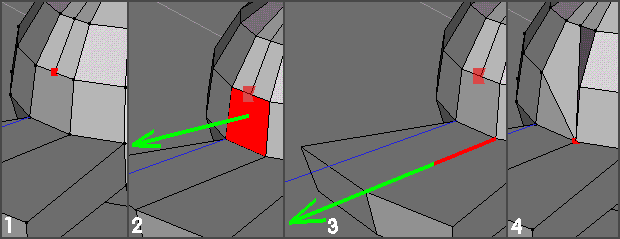 |
| 1). Select an edge 2). Select a plane through which the selected edge will pass - note that as there is no means of specifying a new anchor point with the chosen plane in this option - the inherant anchor point associated with the plane is used. 3). After the op. 4). Another view - here, I've tumbled the model to line up both edges of the plane used, with the newly formed geometry - note how it's all in line. Hopefully, the above sheds a little light on the basics of a very interesting (imo) facility - I might add more stuff as and when time permits etc. |
 |
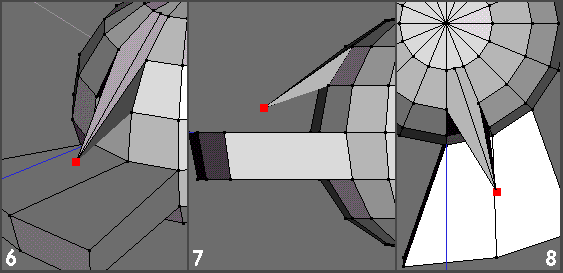 |
 |
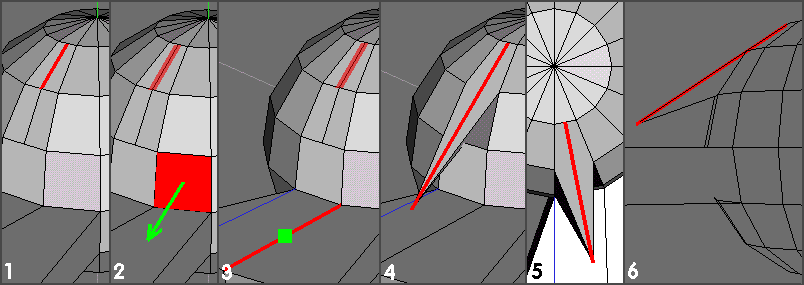 |
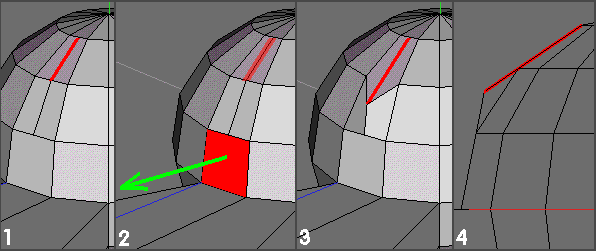 |
| Vert / Edge Intersect With many thanks to Elrond79 we now have an intersect tool. This was originally a plugin, but is now part of the main Wings core. The purpose of this tool is to find the intersection point between a line and a plane and move the selected geometry to the appropriate position - the differences between Intersect and Flatten commands are important and should be noted. What follows is a bit of (basic) info about how to use this tool - messing around / experimentation is definitely recommended. (Original thread (for historical purposes only) where this was mentioned, which includes plug d/l details etc - here NB - There is a Read Me with the plug - so it might be an idea to read that as well :) |
| 1). Select a vert 2). Define the verts' axis of travel / constraint - I selected the edge shown (in red, with yellow vector display) - but note that you don't have to choose any (of the 4, here) edges that are connected to the vert to define this - all usual vector definition options are available. If a line of travel is defined that doesn't pass through (or include) the original selected vert, then the vert will move along a transposed version of the defined axis - ie a line parallel to that defined, but actually passing thro' the selected vert. 3). Define the plane for the verts 'line of travel' to pass through and therefore intersect. I selected the face shown (with normal shown in yellow) 4). Execute the op. - and the tool moves the vert (along line defined in (2)) until it intersects the plane (defined in (3)). Remember that this plane is an infinite one - so, in other circumstances, the vert might well end up 'in thin air' - so to speak - but the (invisible extention) of the originally selected plane will still be the intersect plane. 5). Selected vert now lies on the plane defined in (2) - the presence of the nearly co-incident edge is pure chance. 6). Y view of the result, showing how the vert has travelled along the relevant aspect of the original edge selected in (2). |
| Vert Intersect - MMB option - Stay on plane, move to line. Overview: Select a vert Define the plane you want this vert to stay on. Define the line (of constraint) / axis / edge that has to intersect this plane. Execute op. |
| 1). Select a vert 2). Define the plane that the vert has to stay on - here I chose the face shown (normal displayed in yellow) 3). Define an edge that will pass through the (just specified) plane - if you pick an edge that is close to parallel to the plane, you'll get a message to that effect, indicating that the intersection point would be way, way out (on the 'rim' - for B5 fans? :) ) 4). Execute the op. and the selected vert is then placed at the correct intersection point. |
| Vert | Intersect - RMB option - Pick line and plane. Overview: Select a vert Define the line (of constraint) / axis / edge you want it to stay on Define an anchor point for this (transposed) line of action to pass through Define the plane you want this line to intersect Define an anchor point through which you want (your particular) plane to pass. Execute op. |
| 1). Select a vert. 2). Define an axis - here I picked the edge shown (in red, vector axis shown in yellow) attached to the vert. 3). Define an anchor point for the actual axis to pass through - so - the final destination for this particular vert will lie on a line parallel to the one defined in (2) - but actually passing through the anchor point chosen here, in (3) 4). Define a plane that you want the chosen line to intersect. 5). Define a specific anchor point for the plane to pass through - so, similar to the line procedure, you now have a plane parallel to that chosen in (4) - but it actually passes through the (edge midway) vert chosen in (5). |
| 6). Result of the op 7,8). Other views of the result - since the intersection point (in this case) is a completely virtual one, it would take some messing about to show in detail - but it looked ok by eyeball :) |
| Edge | Intersect. Has L,M,R button options - I'll deal with them in that order - plug can deal with multiple elements being selected - strips only deal with single elements for clarity etc. Edge | Intersect - LMB option - Intersect standard planes. Overview: Select an edge Define the (std.) plane that will be intersected by the selected edge. Execute op. |
| 1). Select an edge 2). Choose one of the available options - I picked Y axis (XZ plane) - but selected it using RMB option as I wanted to choose another XZ plane than the one passing through Wings' origin. 3). I selected the edge shown, thus specifying its mid point as the anchor point for the specific XZ plane wanted here. 4). Situation after the op. 5,6). Other views of the result. |
| Edge | Intersect - MMB option - Pick plane and reference point on plane. Overview: Select an edge Define the plane Define the anchor / ref point through which a plane parallel to that just defined will pass. Execute op. |
| 1). Select an edge. 2). Define a plane - I chose this face, whose normal is displayed in yellow. 3). Define an anchor point, through which a plane parallel to that defined in (2) will pass. 4,5,6) Result of the op, with different views. |
| Edge | Intersect - RMB option - Pick plane. Overview: Select an edge Define the plane Execute op. |
| Vert Intersect. Has L,M,R button options (assuming Advanced Menus enabled) - I'll deal with them in that order - plug can deal with multiple elements being selected - strips only deal with single elements for clarity etc. Vert Intersect - LMB option - Stay on line, move to intersection with plane. Overview: Select a vert Define the line (of constraint) / axis / edge you want it to stay on Define the plane you want this line to intersect. Execute op. |
 |
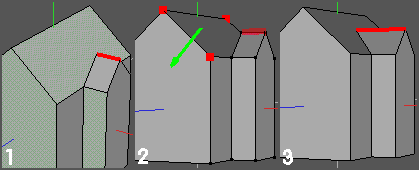 |
 |
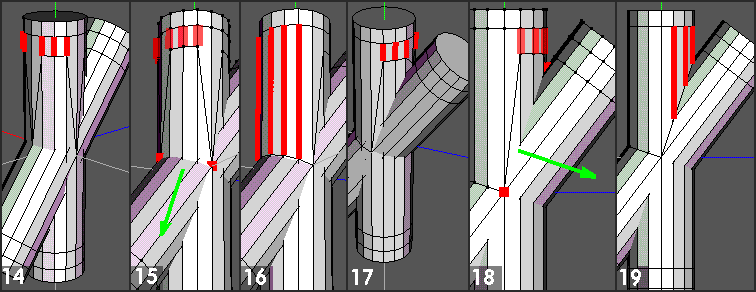 |
 |
 |
| 1). Say you're making a house and you want to make an addition - with the gable end ridge line being properly cut into the main roof. Select edge as shown. 2). Apply Edge | Intersect (use RMB option, pick plane) and select the 3 verts as shown - the normal of this plane is shown in yellow. I didn't pick the main (7 edged) roof face because it also included the rear (unseen) part of the gable end and would therefore not have produced the correct result. 3). Execute the op. and the edge has been extended to the correct point on the main roof. |
| Some possible examples of the tool in use. Edge | Intersect (RMB option) |
| Edge | Intersect (LMB option) |
| 1). Having connected the vert moved in the first example to the main roof, I now want to 'straighten stuff up'. Select the edge shown. 2). Apply Edge | Intersect (use LMB option, Std. planes) - and choose Y (XZ plane) with RMB, since you want to specify a particular location for the XZ plane to pass through. 3). Select the vert shown (in yellow) - this 'fixes' the Y plane to pass through this point. 4). Result of the op - the tool has moved the end of the edge selected in (1) along the edge vector / axis until it intersects the relevant Y plane. Since the plug can deal with multiple edges, selecting both the edge shown and the corresponding edge (at rear of house) would be a valid (and quicker) option for 'tidying' - if that's what was wanted. (It's also worth noting that non-parallel selected edges will be correctly adjusted / modified. This offers extremely powerful alignment opportunities) (In this particular situation, you could also do a Rad Scale -> 0% (RMB) to align both verts at the same time - see align page) |
| 1). Imagine you've got a situation like this - 2 pipes / rods etc crossing (at an unknown angle) and you want to make them into one unit. (I've assumed (here) that all 4 ends are connected to the rest of the model) In this particular example (cyls of equal dia, etc) the lines of intersection lie on only 2 planes of symmetry (at right angles to each other) and therefore, the essence of the joint actually consists of 4 identical pieces . The approach I'm going to take is to determine the 2 relevant planes and with this information,make only one of the 4 symmetrical joint components, loopcut it out of the situation, mirror it (twice) then weld the completed final assembly unit back into the overall model assembly. There are other ways of getting the same result, of course - something to experiment with? 2). First, we have to form some new geom. that'll allow me to use the chosen workflow. Select all axial edges, connect then bevel, until you've got something similar to that shown - ie new edgeloops outside the 'joint' area. 3). Bevel these new loops a little - amount is unimportant - but enough to make selecting the new edges formed fairly easy. 4). Since there are no features on either of the 2 cyls that provide us with information about the 2 intersection planes, the first job is to create these elements (4 verts will be enough to define both planes, as 2 of the verts will be common to both planes) Select the edge shown - (note it's on the centreline of the cyl) AND the corresponding one on the other (hidden) side of the (same) cylinder. 5). Apply Edge | Intersect (RMB option, pick plane) - select the 3 verts shown (again note they're on the centreline) - this defines the plane (normal shown in yellow) running through the middle of the cyl - and the joint. 6). After the op. showing how the edge has been altered, to intersect the plane defined in (5). 7). Edge on the other side, showing similar has happened. We've now got 2 of the 4 points required. |
| Edge | intersect - various tools. |
| 8). Similar procedure (but different tool option) to get the remaining 2 points. Select the edge shown (on centreline) AND the corresponding one on the other (upper) side of the same cylinder. 9). Apply Edge | Intersect (MMB option, pick plane and ref. point on plane) and select the same 3 verts (shown in red) as before (step (5)) to define the same central plane (normal shown in yellow) of the cylinder as used in (5). Whilst this plane is the same as used before, we want it to pass through the uppermost axial edge of the angled cylinder this time. (see next step) 10). Pick the top (central) vert shown (yellow) to define where you want the plane to pass through. 11). Execute the op. - note what's happened - lower end of line selected in (8) has now intersected the upper central edge of the angled cylinder. 12). Similar situation on the other side - but obviously more movement because of the angle involved. We now have all 4 verts necessary to define both planes of intersection (of the joint) 13). Just selected the (modified) edgeloop to show what's happening - on 2 of the 4 positions. |
| 14). Now going to create the 2 lines of intersection required. Select the 3 intermediate edges shown and the 'other 3' just around the 'corner' (as it were) - no need to select the middle edge, as it's already where it should be. 15). Apply Edge | Intersect (RMB) and pick the 3 verts necessary to define the relevant plane (for this side of the joint) - 2 shown here (in red) - should be obvious where the other vert is? 16). Situation afterwards. 17). Repeat the procedure for the other half of the cylinder. Select the relevant 6 edges 18). Intersect (RMB), pick the appropriate 3 verts (2 the same as previous sequence) to define the plane for this side of the cyl. 19). Situation afterwards - Now have all the necessary info to actually make the complete joint. |
| 20). Shows what the relevant (joint) edgeloop looks like. 21). Going to loopcut the whole 'joint' arrangement from the rest of the model - select all the edgeloops shown and apply Edge | LoopCut. 22). Select the objects shown and hide / dump them. 23). Select the face shown (you'll have to select the 2 verts at the bottom of this piece and connect them first) 24). Mirror object, select both (end) faces and dissolve - to form a single one - then mirror again around this face. 25). Select whole object and apply Object | Weld. - appropriate verts shown selected after the op. As said before, this is only one way for getting this result - but imo, it's worth keeping the old 'mince pies' (eyes, for ESL readers) peeled for lines of symmetry etc - it might make things easier. Depending on the surrounding geom. on a particular model (if you want to use the above procedure) you probably won't have to create the stuff I did with bevel in the early stages etc. |
| Now going to repeat the previous sequence - but using the other face (on same plane) that faces in the opposite direction. 7). A reference frame only (like (1) ) showing the normal for the selected face. 8). Select same edge as previous strip and apply Edge | Intersect (RMB option) 9). Select same face as (7) - note display direction (in yellow) 10). Final arrangement after executing the op - again, note how the vert (on selected edge) behind the the defined 'target' face (plane) has moved (along its edge) in the same direction as the vector (and normal) display - until it hits the 'target' plane 11) View -> Y (ortho) of the final situation - note how the (LHand) vert on the selected edge is now aligned to the 'target' face (plane). To summarise: If the selected edge straddles a target plane then the vert being moved depends on which direction the normal of the target plane is pointing. The vert behind the target plane will move - in the direction of the plane normal - until it hits the plane. |
 |
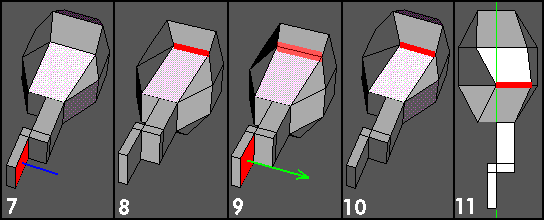 |
| Edge | Intersect - Additional info. In the 3 previous strips, I've chosen very simple examples of the 3 options to demonstrate the basics of the way the plugin works. ie The whole of the selected edge has been on one side of the 'target' plane, so the vert that's nearest to the plane has moved towards the plane. However, there are situations that require further explanation - eg when the selected edge 'straddles' the target plane - so there'll be a vert on either side of the plane. In this case the vert being moved depends on which direction the normal of the (target) plane is pointing.. The following sequence (1) - (11) will hopefully illustrate what's happening. |
| 1). I've used a modified (and extended) Octotoad as a starting point - In this frame I've selected the plane that'll be used first, so that its normal (in blue) can be seen. This pic is purely for reference purposes. 2). View -> Y (ortho) of the object, with the selected edge (in red) and the line of the plane (mentioned in (1) ) - this 'plane' line (yellow) has been added in Photoshop - Wings does NOT display such a line. Note that the extruded geometry offers 2 faces (on the same plane), but facing in the opposite direction. This view also shows that the selected edge 'straddles' the plane in such a manner that the edge verts are different distances away from the plane line - ie the plane does not bisect the edge - into equal chunks. 3). Another view of the start position. Apply Edge | Intersect (RMB option - pick a plane) 4). Select the face shown (same as in (1) ) and note the direction of the plane's normal vector display (in yellow) - again the same as (1). 5). Execute the op. and the vert behind the selected face (plane) is moved along its edge until it intersects the plane. 6). View -> Y (ortho) of the final arrangement - note how the (RHand) vert is now aligned to the line of the plane. |